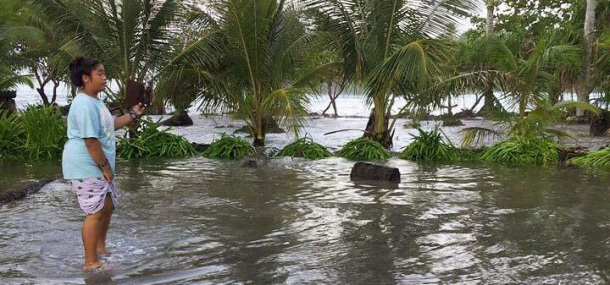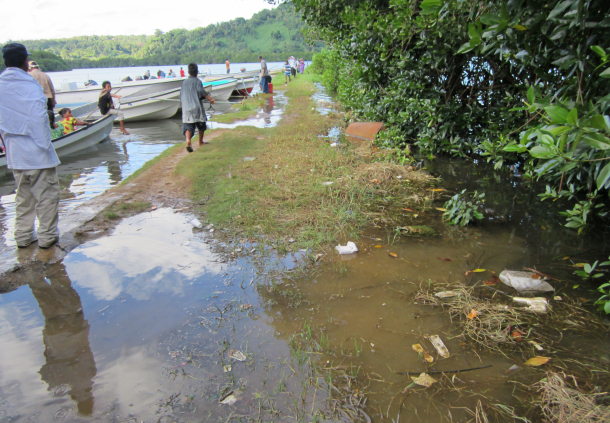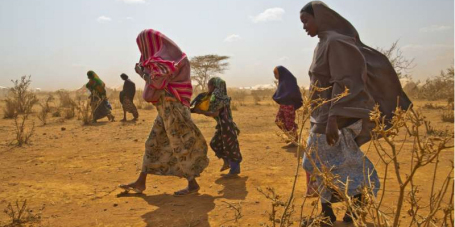Shrinking Islands and Climate Mobilities in the Pacific
“To remove a people from their ancestral, natural surroundings or vice versa, or to destroy their lands (…), is to sever them not only from their traditional sources of livelihood, but also and much more importantly, from their ancestry, their history, their identity, and from their ultimate claim for the legitimacy of their existence.”
Although Tongan scholar Epeli Hau’ofa (2000: 468-469) did not explicitly refer to climate change, rising temperatures, increasing variability of weather patterns and higher frequency of disastrous weather events are rapidly deteriorating living conditions on the Small Island Developing States (SIDS). The “sinking” Pacific Islands are thus depicted to be the source of the future “human tidal wave” (Bogardi & Warner 2009; Christian Aid 2007). Much speculation is supported by hardly any reliable case-studies and often brute generalisations about “the islands” as vulnerable “geographical objects” (Barnett & Campbell 2010) are drawn from scattered information, ignoring individual geomorphological, ecological, cultural, historical, economical and political settings (for a good policy-focused overview of climate change and migration in the South Pacific, see Burson 2010).

Over 600 people have been evacuated from affected areas in Majuro (Marshall Islands) following high tide inudation March 3 2014 © OCHA Pacific
The settlement and successful occupancy of this “sea of islands” (Hau’ofa 1994) engendered mutual mobilities and moorings which served to alleviate ecological pressures. Unequally distributed environmental endowments, droughts and typhoons were handled along clan lines or inter-island trade and tribute networks (cf. Alkire 1965). Rearranged by colonial logic to suit political and economic endeavors (cf. Lieber 1977), today's transnational networks provide assistance to the islanders in the form of health care, education, economic and social remittances (cf. Hezel 2013). As in traditional navigation, the way forward is thereby to orientate one’s self in relation to the island left behind and mobilities are rooted in the continuing bonding with the home islands (cf. Lee & Francis 2009). Regular visits back and forth, lively exchanges via social media, coolers sent full of island food and the practice of leaving a family member behind as the custodian of the land all testify to the continued sense of “belonging” of islanders in the diaspora. “Belonging” in Oceania is thereby founded in relations to kin and land, ultimately illustrated in the return upon death to be buried on the land of origin and amongst kin. How, then, does climate change effect the notions of Pacific “belonging”? Does the erosion of islands wash away identity or can the loss of land be compensated by active island diasporas along the Pacific rim? The following will delineate the cultural space of climate mobilities in the Pacific, before turning towards existing mobility regimes and single island examples.
Land is essential to a Pacific Islander's sense of individual and collective self (cf. Campbell 2010). Older people especially state to prefer to go down with their island than leave it. (1)
(1) The author spent one year in Chuuk, Federated States of Micronesia in 2011-2012 for ethnological field research on the impact of climate change on local perceptions of “nature” and “space”.
Younger people, on the other hand, often wish to escape the restricted physical and cultural space of their islands and to venture out into the “world out there”. Gender also plays a role. In Chuuk, the most populous state of the four Federated States of Micronesia (FSM), the notion of movement/leaving and mooring/staying is culturally gendered. It finds linguistic expression in the local terms of feefinitiw, meaning that women who matrilineally inherit land stay on it to take care of it, while mwááninó alludes to the movement of men from the land in order to fish, trade and connect with kinsmen on other islands. Hence, when a mother dies, she not only transfers the physical land to her daughters to secure their economic base, but she also passes on related stories, genealogies and traditional environmental knowledge. Another important factor in dealing with climate change in the Pacific is Christianity. Islanders often refer to the covenant God made with Noah to never flood the Earth again, transferring fate and responsibility to their faith. Were, for example, Tuvalu to be evacuated, the social impact would mainly derive from the “existential tragedy of the loss of Tuvalu as God's place for the Tuvaluans” (Mortreux & Barnett 2009: 110).

Flooding in Chuuk 2011 © Hofmann
In Chuuk, as elsewhere in the Pacific (cf. Campbell 2010), some 95% of the land is under traditional, that is collective but private, land tenure (Hezel 1994). The remaining five per cent is all on the municipal island and were alienated during former foreign regimes (Spain, Germany, Japan, USA), and now host the hospital and other governmental institutions. A relocation of people within culturally connected island groups would thus have to be administered by kin groups rather than by the government. The obligation of sharing and hosting relatives, however, can quickly become a burden even on the larger volcanic islands when the natural resources on which the people's subsistence rely become diminished by either overexploitation or environmental deterioration. These islands also do not represent a “save haven”, but are just as prone to natural hazards such as typhoons, mudslides or droughts.
In the most extreme case, islanders might become “stateless” (cf. Blitz 2011). Most islands, however, will become uninhabitable long before they completely vanish. While legal scholar Jane McAdam (2010) points out that the absence of population and an ineffective government will be preceding elements of “disappearing” SIDS, Maxine Burkett (2011) suggests an “Ex-Situ Nation” category to establish a governmental framework that allows to exercise authority over a diffused people in a post-climate era. To counter the loss of state powers, Kiribati's president Anote Tong wants to establish a small government outpost on the state's only high ground, on Banaba Island, in order to retain the state and its control over the resources covered by the vast Exclusive Economic Zone (EEZ) (McAdam 2010: 126). Others, again, envisage a Conservation and Marine Management Area to uphold the link to their ancestral locale (Tulele Peisa n.d.).
Nevertheless, to the I-Kiribati, more important than to conserve a state is to preserve their cultural community and identity, which again, is deeply connected to their land (McAdam 2010; cf. Oliver-Smith 2009). It is therefore critical to keep a balance between long-term planning which prepares for resettlement and in situ adaptation efforts to postpone relocation for as long as possible. While island politicians have become very active in promoting the destiny of their people, the individual states pursue diverse strategies. The president of the FSM, Manny Mori, emphasises how they “have nowhere to run” (Mori 2012). He is flanked by other island leaders who find the threat of displacement unacceptable (cf. Mortreux & Barnett 2009; Farbotko 2010). At the same time, however, thousands of islanders have long left and are still leaving the islands every year, sending home remittances and enabling chain migration (Hezel 2013).
In spite of the culture inherent duality of place attachment and mobility, gradual relocation along family chains is often seen as a successful and culturally rather acceptable adaptive feature of island life, while those without such ties are most vulnerable. Self-determination is hereby crucial, but not necessarily key to success as the famous example of the Carteret Islanders shows. “Tulele Peisa” means “sailing in the wind on our own” and is the name of an NGO, initiated by the Carteret Council of Elders. It seeks to administer the relocation of the approximately 3,500 atoll islanders to the large island of Bougainville. Customary farewell and welcome ceremonies, exchange programmes and intermarriages are part of the NGO's strategy. It wishes to help the sea-oriented “Carteret people to adapt to a different lifestyle from the coral atolls to mainland Bougainville,” where gardening, and not fishing, is the major food sector (Tulele Peisa n.d.). They have learned their lessons from an earlier Atoll Resettlement Project which failed in the 1980s due to insufficient economic security and related difficulties to retain socio-cultural self-reliance (O’Collins 1990). Just as people eventually moved back to the atoll in order not to lose their land claims there, the first families of the new relocation programme in 2009 returned already after a couple of months – for still the same reasons. Bougainville is almost completely in collective ownership and the little land the Catholic church allocated to the Carterets was far from being enough. And in spite of the NGO's cultural endeavor, the social reception also proved difficult (Boege 2011).
Due to its negative connotations, most islanders reject the prospect of becoming “refugees” (McAdam 2009; cf. Bettini 2013), a label which is also at the core of much academic debate (e.g. Black 2001; Castles 2010; Hugo 2010). Objecting the stigmatisation, Kiribati aims instead to “migrate with dignity” which envisages the expansion of existing migration schemes such as New Zealand's “Pacific Access Category”, the “Recognised Seasonal Employment” with New Zealand or the “Kiribati Australia Nursing Initiative”. Yet, these programmes are restricted to a small number of people, only apply to a certain socio-demographic group and do not acknowledge any link between environmental degradation and migration. The “brain drain”, meanwhile, could threaten island institutions such as schools, health care and public authorities long before waves wash them away (Barnett & Adger 2003). To Kiribati, such migration regimes are nevertheless an adaptational measure and it seeks to extend such possibilities even beyond the region, for example to Canada and Croatia (Klepp 2012: 11). Additionally, it negotiates land sales with Fiji to grow food for Kiribati and to settle some 500 I-Kiribati (Klepp 2013: 414). Again, this ties in with historic predecessors. During British colonial times, Banabans from the Gilbert Islands (Kiribati) were relocated to Rabi (Fiji) due to the irreversible environmental damage from phosphate mining. Still in Fiji today, they continue to uphold strong links to their home state (Campbell 2010).
Thus, mobility due to environmental issues is not new to the Pacific. Neither is environmental change the sole driver of large-scale and long-term migration beyond the islands. The discursive formation of “climate change” thereby includes an eco-colonial dimension (Farbotko 2010) in which smallness and isolation are applied by the media, by organisations of international cooperation and by scholars victimising the islanders without taking into account their adaptive capabilities which have ensured their survival for thousand of years. Such language, however, is also employed by island governments which use climate change as a “garbage can” where they dump and divert from unsustainable resource use and other local issues (Connell 2003) or to give islands a “big smallness” in global politics, enlarging them by the influx of attention and aid (Goldsmith 2015, forthcoming). Hence, along with Mortreux and Barnett (2009: 111), it must be emphasised that “individuals and communities respond to events and information, things do not just happen to people”. It is thus the big challenge for politics to find solutions which anticipate and prepare for culturally sensitive long-term solutions while not impeding current in situ adaptation efforts. Furthermore, any action should include and empower culturally important decision makers which are often represented by churches rather than by governments. In the end, the highest aim must be to allow Pacific Islanders to retain their sense of self, embedded in the Oceanic dialectic between moorings and mobilities.
- Alkire, W. H. (1965) Lamotrek Atoll and Inter-Island Socioeconomic Ties. Urbana, University of Illinois Press.
- Barnett, J. & Adger. W. N. (2003) Climate Dangers and Atoll Countries. Climatic Change 61 (3), p. 321–37.
- Barnett, J. & Campbell. J. (2010) Climate Change and Small Island States Power, Knowledge, and the South Pacific. London/Washington, D.C., Earthscan.
- Bettini, G. (2013) Climate Barbarians at the Gate? A critique of apocalyptic narratives on climate refugees. Geoforum. 45, p. 63–72.
- Black, R. (2001) Fifty Years of Refugee Studies: From Theory to Policy. International Migration Review. 35 (1). Special Issue: UNHCR at 50: Past, Present and Future of Refugee Assistance, p. 57–78.
- Blitz, B. K. (2011) Statelessness and Environmental-Induced Displacement: Future Scenarios of Deterritorialisation, Rescue and Recovery Examined. Mobilities. 6 (3), p. 433–50.
- Boege, V. (2011) Challenges and Pitfalls of Resettlement Measures: Experiences in the Pacific Region. Working Papers - Center on Migration, Citizenship and Development. Bd, 102, Bielefeld.
- Bogardi, J. & Warner. K. (2009) Here Comes the Flood. Nature Reports Climate Change. 3 (0901), p. 9–11.
- Burkett, M. (2011) The Nation Ex-Situ: On climate change, deterritorialized nationhood and the post-climate era. Climate Law. 2, p. 345–74.
- Burson, B. (2010) Climate Change and Migration: South Pacific Perspectives. Wellington, Institute of Policy Studies.
- Campbell, J. (2010) Climate-Induced Community Relocation in the Pacific: The Meaning and Importance of Land. In: McAdams, J. (ed.). Climate Change and Displacement: Multidisciplinary Perspectives, p. 57-79. Oxford/Portland, Hart Publishing.
- Castles, S. (2010) Afterword: What Now? Climate-Induced Displacement after Copenhagen. In: McAdams, J. (ed.). Climate Change and Displacement: Multidisciplinary Perspectives, p. 239–46. Oxford/Portland, Hart Publishing.
- Christian Aid (2007) Human Tide: The Real Migration Crisis. A Christian Aid Report. London, Christian Aid.
- Connell, J. (2003) Losing Ground? Tuvalu, the Greenhouse Effect and the Garbage Can. Asia Pacific Viewpoint. 44 (2), p. 89–107.
- Farbotko, C. (2010) Wishful Sinking: Disappearing Islands, Climate Refugees and Cosmopolitan Experimentation. Asia Pacific Viewpoint. 51 (1), p. 47–60.
- Goldsmith, M. (2015) The big smallness of Tuvalu. Global Environment, Special Issue: Small Islands and Natural Hazards. 8.1, p. 134-151
- Hau’ofa, E. (1994) Our Sea of Islands. The Contemporary Pacific. 6 (1), p. 147–61.
- Hau’ofa, E. (2000) Epilogue: Pasts to Remember“. In Remembrance of Pacific Pasts. An Invitation to Remake History, p. 453–71. Honolulu, University of Hawai’i Press.
- Hezel, F. X. (1994) Land Issues in Chuuk. Micronesian Counselor, 16.
- Hezel, F. X. (2013) Micronesians on the Move: Eastward and Upward Bound. Honolulu, East-West Center.
- Hugo, G. (2010) Climate Change-Induced Mobility and the Existing Migration Regime in Asia and the Pacific. In Climate Change and Displacement. Multidisciplinary Perspectives, p. 9 35. Oxford/Portland, Hart Publishing.
- Klepp, S. (2012) Klimawandel und Mobilität - rechtliche Diskurse und Lösungsansätze für Umweltmigranten im Pazifkraum. artec paper, 180.
- Klepp, S. (2013) Kleine Inselstaaten und die Klimabewegung: Der Fall Kiribati“. In Die internationale Klimabewegung, 39, p. 409–24. Bürgergesellschaft und Demokratie. Wiesbaden, Springer VS.
- Lee, H. & Francis. S. T. (2009) Migration and Transnationalism Pacific Perspectives. Acton, Australian National University Press.
- Lieber, M. D. (1977) Exiles and Migrants in Oceania. Honolulu, University of Hawaii.
- McAdam, J. (2009) We aren’t refugees: Inside Story. Inside Story. Current affairs and culture from Australia and beyond.
- McAdam, J. (2010) Disappearing States, Statelessness and the Boundaries of International Law. In In: McAdams, J. (ed.). Climate Change and Displacement. Multidisciplinary Perspectives, p 105 -29. Oxford/Portland, Hart Publishing.
- Mori, E. (2012) Address by H.E. Emanuel Mori President of the Federated States of Micronesia Before the United Nations Conference on Sustainable Development Rio de Janeiro, 21 June 2012. United Nations Conference on Sustainable Development.
- Mortreux, C. & Barnett. J. (2009) Climate Change, Migration and Adaptation in Funafuti, Tuvalu. Global Environmental Change. 19 (1), p. 105–12.
- O’Collins, M. (1990) Carteret islanders at the Atolls Resettlement Scheme: a response to land loss and population growth. Implications of expected climate changes in the South Pacific Region: an overview.
- Oliver-Smith, A. (2009) Sea Level Rise and the Vulnerability of Coastal Peoples Responding to the Local Challenges of Global Climate Change in the 21st Century. Bonn, UNU-EHS.
- Tulele Peisa. (n.d.) Tulele Peisa. Sailing the waves on our own. Tulele Peisa.


